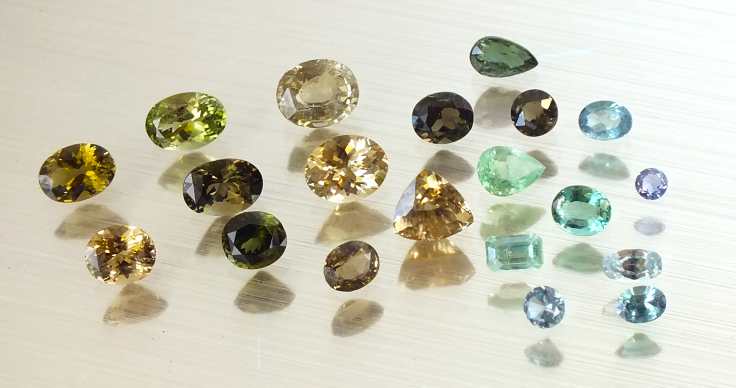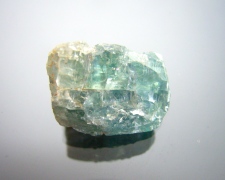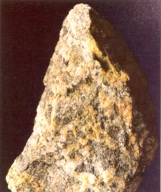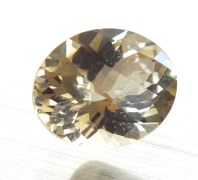 |
| スリランカ、タンザニアと新たに出現したマダガスカルとケニアのコルネルップ石 0.20〜3.26ct Kornerupines from Srilanka, Tanzania and Madagascar |
コルネルップ石(コーネルピン:Kornerupine)
 |
| スリランカ、タンザニアと新たに出現したマダガスカルとケニアのコルネルップ石 0.20〜3.26ct Kornerupines from Srilanka, Tanzania and Madagascar |
 |
 |
 |
 | |||
| 宝石質結晶片 16x11x7mm Gemmy Crystal flagment Tanzania |
花崗岩中の結晶 4cm (Crystals in Granite) Waldheim, Germany |
Kornerupine
90mm Lac Ste. Marie, Canada |
30x15x11mm Horombe, Finarantsoa Madagascar |
| 結晶系 (Crystal System) |
結晶形 (Crystal Form) |
化学組成 (Composition) |
モース硬度 (Hardness) |
比重 (Density) |
屈折率 (Refractive Index) |
| 直方晶系 (Orthorhombic) |
 |
Mg(Al・Fe)6[(O・OH)2/BO4(SiO4)4] | 6½ - 7 | 3.28-34 | 1.67-69 |
名前と産状 (Name and Occurence)
コーネルピンは1883年にグリーンランドから初めて報告され、グリーンランド探検家であったデンマークの地質学者のA.N.Kornerup(1857-1883)に因み1884年に命名された鉱物です。
デンマーク語の発音に従えばコルネルップ石と呼ぶのが正しい呼称です。
一般には英語読みのコーネルピンが通称です。
語尾の -ine はギリシア語源の ・・・ に似た、・・・ の性質の、を意味する形容詞語尾で、Almandine (鉄礬柘榴石)、Spessartine(満礬柘榴石)、蛇紋岩(Serpentine)等々鉱物名や、marine, feminine 等ラテン語を経由して広くヨーロッパ語に使われています。
コーネルピンはスカルンやペグマタイト性の変成作用で出来る稀少な鉱物で菫青石、正長石,白雲母と共に生成します。
産地はドイツのワルトハイム( Waldheim)、グリーンランドのフィスケルネス (Fiskernäs)、オーストラリア中央部のハーツ山脈等です。
宝石質のコーネルピンは1912年にマダガスカルのペグマタイト鉱床から発見されました。
1936年にスリランカの漂砂鉱床からかなりの量が採れるようになり、スリランカが主要な供給地となりました。
その後ビルマのモゴク、カナダのケベック州の聖マリア湖等からも報告されています。
近年になってケニアやタンザニアの国境地帯を流れるウンバ川から、明るく美しい色合いの淡青や淡緑のものが発見されています。
一般の鉱物事典に記載されないことすらある稀な鉱物です。
当然ながら宝石にカットされるような石は稀にしか採れません。
スリランカが主要な産地ですが多くは魅力の無い暗褐色が大半です。
稀に渋いパステル・カラーがあります。
近年タンザニアとマダガスカルからは緑柱石のような緑や青の石が採れます。
しかし大半が1カラット以下の小さな石を稀に見かけるのみです。
そんな事情ですからコーネルピンはコレクターの宝石と言えるでしょう。
Kornerupine was first reported in 1883 from Greenland and was named in honor of Danish geologist and explorer of Greenland, Andreas Nikolaus Kornerup(1857-1883).
Kornerupine is a rare mineral typically occurs in strongly metamorphosed rocks, as granulites, associated with cordierite, orthoclase, biotite etc. Crystals up to 230mm across known from Fiskenaesset, Greenland. It also occurs in Lac Ste. Marie, Quebec, Canada ; Waldheim, Germany; and Itrongay, Madagascar, Harts Range and Strangways Range, Central Australia.
In 1912, first gemmy crystal was reported from pegmatite in Madagascar but gem gravels of Srilanka has been the major source of gem kornerupine since 1936, followed by Umba Valley region along Kenya and Tanzanian border with bright pale blue and green stones. In general, kornerupine is so rare and is often omitted from mineral cyclopedias. Consequently, gem kornerupine is faceted only for collectors ; dark brownish-green Srilankan stones or beryl like bright pale blue and green stones of recent find from Tanzania/Kenya and Madagascar but most of them are small stones of less than one carat.スリランカのコーネルピン (Srilankan Kornerupine)
[上]コーネルピン(Kornerupine) 17ct [下]ダンベリー石と珪線石
(Danburite and Sillimanite)1.48ct 7.2x6.5mm 1.46ct 9.0x6.5mm 2.19ct 9.7x6.8mm 1.84ct 9.2x6.6mm 2.97ct 8.6x8.3mm 1.58ct 8.0x6.7mm 鉄分の多いコーネルピン
(Kornerupine with high iron content)
3.26ct 9.6x6.7mm 1.00ct 6.9x5.3mm 2.20ct 9.5x7.6mm
漂砂鉱床での採掘(Small scale mining at alluvial deposits) Elahera
Embilipitiya
新生代(6500万年〜) 前カンブリア代(5億7千万年以前) ハイランド・グループ ヴィジャヤン複合帯 南西グループ スリランカの地質図
(Geological map of Srilanka)宝石採掘地域
スリランカのコーネルピンの包有物(Inclusions in Srilanlan kornerupine) 燐灰石(apatite) 40x ルチル(Rutile) 35x ジルコン(Zircon) 35x
スリランカは世界で最も多様で豊かな宝石産地です。
6万6千平方kmの面積の20%に達する地域が宝石産出地と推定されます。
紀元前から現在に至るまで採掘されたのはごく一部に過ぎません。
依然として広大な土地に未採掘の宝石が残されています。
島の地質はほぼ大半が前カンブリア時代(5.7億年以前)の古い地質に属しています。
宝石は島の南西から北東へ縦断する南西コンプレックスと、中央高地コンプレックスと呼ばれる柘榴石花崗岩、片岩、片麻岩,大理石等が入り混じった地層に産し、宝石は永年の間に風化した砂利と共に畑や森の地下に堆積しています。
Srilanka may have the greatest proportion of land surface underlain by gem deposits, as well as the widest variety of gem minerals, of any country in the world. In Srilanka, although gems have been mine more than 2000 years, there remains vast areas of gem potential undevelopped. A geologic sketchmap shows that the island is almost entirely underlain by Precambrian rocks. These rocks can be divided into three groups based on their lithology, structure, and age, as described below ;
The oldest unit on the island is the Highland group, which contains rocks of the metamorphic granulite facies. Most of the gem deposits are located within this group. The second unit is the Vijayan complex. This unit is charcterized by rocks of the almandite-amphibolite facies.
Almost all of gems in Srilanka occur in alluvial deposits.
コーネルピンはマタレ、ラトナプラ、エンビリピティヤ等、島の数ヶ所の漂砂鉱床から報告されています。
いずれも鉄分の濃度が高く、暗褐色や暗緑色の地味な石でジルコンやエンスタタイトを思わせます。
ジルコンとは比重や複屈折量が異なリ、識別は簡単ですが、エンスタタイトとは色合いや比重,屈折率等が重なり、識別は非常に困難です。
特にスリランカではエンスタタイトと一緒に産出しますが、研磨する前の原石の場合はモース硬度が 5½ と低いエンスタタイトとの識別は簡単でしょう。
ルースの場合はコーネルピンは燐灰石やルチル,ジルコンの結晶を含むことが特徴で識別が可能となります。
コーネルピンは、時には数kgもの原石が採れることもあリますが、一般には稀な鉱物で市場でルースを見かける機会は多くはありません。
Kornerupine is reported from several alluvial deposits ; Matale, Ratnapura, Embilipitiya, etc. All of Kornerupine of Srilanka are high iron contents type to show dark brown to dark green colors and resembles zircon and enstatite. It is easy to separate kornerupine from zircon, thanks to diffences of density and birefringence, but enstatite has the close characteristics and color as kornerupine. The higher Mohs hardness of kornerupine against lower hardness of enstatite enables to separate these two minerals, before cutting. Faceted stones may be separated with inclusions of apatite, rutile and zircon inclusions, often seen in kornerupine.
スリランカ産のルースは初めてツーソンに行った時にスリランカの稀少石の専門家から直接求めたものです。
一般のスリランカ産の褐色のものと比べると地味ながらも多彩な色合いで非常に美しいものです。
それがカラット当り5ドルと破格の水準でした。
当時はコーネルピンについても、価格の相場についてもまるで無知でしたが、今から考えると何故そんなに安かったのか不思議なくらいです。
現在では余り美しくない褐色のものでも50ドルくらいの水準です。
その後ツーソンには何度も行きましたが,結局最初にめぐり合ったのがもっとも品揃えが豊富で価格も妥当な専門家であったのだと思い当たりました。
その後こんなに美しいスリランカ産のコーネルピンにはトンとお目にかかりません。
タンザニアのコーネルピン (Tanzanian Kornerupine)
宝石質結晶(Gemmy crystal) 16x11x7mm 0.40ct ø4.5mm 0.51ct 6.5x3.6mm 0.65ct 6.2x4.0mm 0.53ct 5.5x4.0mm
タンザニアもスリランカと同様に数十種類の多彩な宝石を産する土地です。
サファイアやガーネット、ゾイサイト等、他の産地とは異なる魅惑的な色合いの変種が次々と報告されるので目が離せません。
コーネルピンもその例に漏れず、スリランカ産と比べると同じ宝石とは思えません。
まるで緑柱石のような明るく透明度の高い結晶が得られます。
青と緑はそれぞれ微量のクロムとヴァナジウムによる発色と思われます。
惜しむらくは1カラット未満の小さなルースしか得られません。
写真のように無数の亀裂が入った小さな結晶ではそれも仕方がありません。
産地はウンバ川流域と思われます。結晶を見る限り漂砂鉱床の水磨礫ではなく一次鉱床のものです。
タンザニア産の緑柱石のようなコーネルピンは、近年人気が高まり、1カラットを超える美しい色合いのルースはカラット当たり 1000 ドルの高値で取引されるほどです。
Tanzania is one of the most significant gem producing country, like Srilanka, with rich varieties of gem species and many of Tanzanian gems have outstanding color varieties, compared to other localities, such as ; sapphire, garnet, zoisite, etc. etc. Tanzaian kornerupine is that representative example for attractive beryl-like transparent blue and green colors.
Blue is attributed to minor chromium and green is vanadium impurities. It is great regret that almost all faceted stones are small ; less than one carat size. Heavily fissured small crystal suggests the origine as in-situ and not from alluvial deposit, somewhere along The Umba River.
ケニアのコーネルピン(Kornerupine from Kenya)
ケニア産と称する緑柱石のようなコーネルピンを見た時には、タンザニア産の誤りではないかと思いました。
ケニア産のコーネルピンに関する情報を見たことがなかったからです。
写真のように、タンザニア産とそっくりの色合いです。
よくよく調べてみると、スイスの宝石学者、ギューベリン博士のコレクションに3点のエメラルド・グリーン色のコーネルピンがあり、いずれもケニアのインド洋岸に近い、Kwale district産とあります。
正式な情報はありませんが、ケニアの新しい産地であることは間違いないようです。0.69ct 6.7x5.6mm
マダガスカルのコーネルピン (Malagasy Kornerupine)
0.20ct ø3.6mm 0.67ct 6.3x4.6mm 1.86ct 8.12x5.15mm 1.40ct 8.33x5.20mm 1.25ct 7.2x6.0mm 0.76ct Ø5.3mm 宝石質のコルネルップ石は1912年にマダガスカルで最初に発見されました。
以後、ベトラカ (Betraka)やフィナランツオア (Finarantsoa)、その他島の至る所にあるスカルン性の石灰岩の変成鉱床からコーネルピンが発見されます。
しかしながら、これまで市場に出回っていたのは殆ど黒に近い暗緑色で,コレクションとしても魅力がある宝石ではありませんでした。
ところが2008年初めにまるで緑柱石のような明るく透明度の高い石が出現しました。
前述のタンザニア産と見分けがつかないほど似ています。
いずれも殆ど鉄分を殆ど含まないためと考えられます。
今のところ、同様にごく小さなルースしかなく、詳細な産地情報もありません。
It was in 1912, that gemmy kornerupine was first discovered In Madagascar. Since then, dark green, almost black kornerupine has been found at Betraka, Finarantsoa, and elsewhere metamorphic skarn veins of Island.
However, although small, bright pale blue kornerupine with high transparency, which terribly resembles Tanzanian stone, appeared in early 2008. There are no detailed information about exact locality, yet.